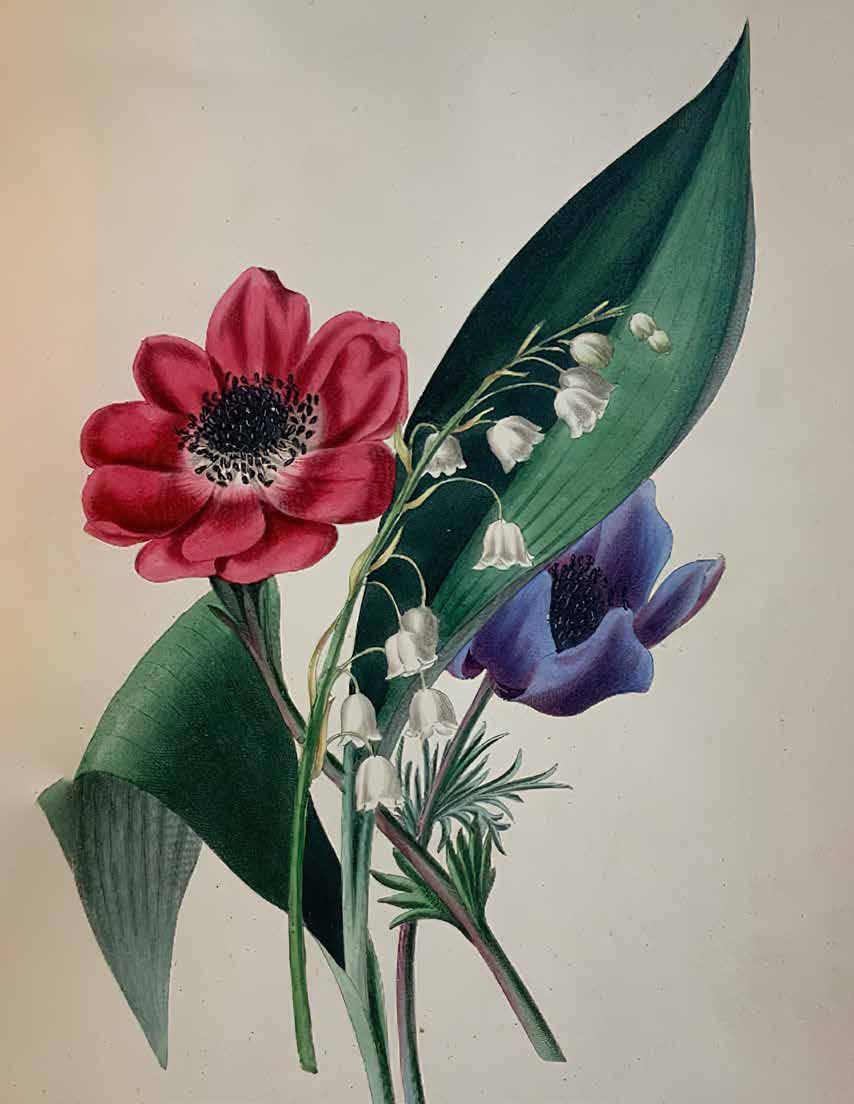
HSA Board of Directors
Linda Lange President
Betsy Smith Vice President
Maryann Readal Secretary/Communications
Laura A. Mullen Treasurer/Finance
Gayle Engels Botany & Horticulture Chair
Open Education Chair
Open Development Chair
Casey King Membership Chair
Rosemary Lovall-Sale Honorary President
Membership Delegates
Open Central District
Krystal Maxwell Great Lakes District
Kim Labash Mid-Atlantic District
Roxanne Varian Northeast District
William "Bill" Varney South Central District
Sharon Hosch Southeast District
Lisa-Marie Maryott West District
Administrative Staff
Laura Lee Martin Executive Director
Karen Kennedy Educator
Lisa Murphy Development and Membership
Becky Geissinger Financial Services
Kateri Kramer Digital Media and Marketing
Cindy Gill Accountant
The Herbarist
Debbi Paterno Publication Design, Debbi Paterno Graphic Design
SP Mount Printing Printer
The Herbarist Committee
Lois Sutton, PhD Chair
Maryann Readal HSA Secretary
Jean Berry
Shirley Hercules
Gayle Southerland
Barbara J. Williams
The opinions expressed by contributors are not necessarily those of The Society. Manuscripts, advertisements, comments, and letters to the editor may be sent to:
The Herbarist, The Herb Society of America 9019 Kirtland-Chardon Rd., Kirtland, Ohio 44094 440.256.0514 www.herbsociety.org editorherbarist@gmail.com
The Herbarist, No. 87
© The Herb Society of America
A complete list of sponsors and underwriters may be found on page 56. Cover art from The Romance of Nature, or, the flower-seasons illustrated Louise A. Talmey, 1836.
Front cover sponsored by Maryann and Tom Readal
As if no artifice of fashion, business, politics, had ever been,
Forth from its sunny nook of shelter’d grass- innocent, golden, calm as the dawn, The spring’s first dandelion shows its trustful face.
Walt Whitman, Leaves of Grass, 1891 - 1892
o one has ever chosen dandelion as Perennial of the Year or Herb of the Year. I doubt they ever will! Dandelion is a highly adaptive diverse species. It can colonize widely differing habitats, from a fertilized dense lawn to bare soil between plants in a tilled field. Most people consider dandelions “weeds.”
Taraxacum officinale (L.) Weber ex.F.H.Wigg, dandelion, is not native to the New World. Europeans brought them to the west for use as a potherb. This member of the Asteraceae family is an invasive species that has naturalized in North America quite easily (Baumgradt, 1982). Botanists have identified several distinct dandelion biotypes (plants of one species that are different genetically). To some degree these biotypes specialize in their
choice of habitats. A dandelion that is in an environment that complements its biotype produces more seed heads than it would in a less complementary environment. This is because of differences in the root hairs, which absorb water and soil nutrients (Michigan State University, 2015).
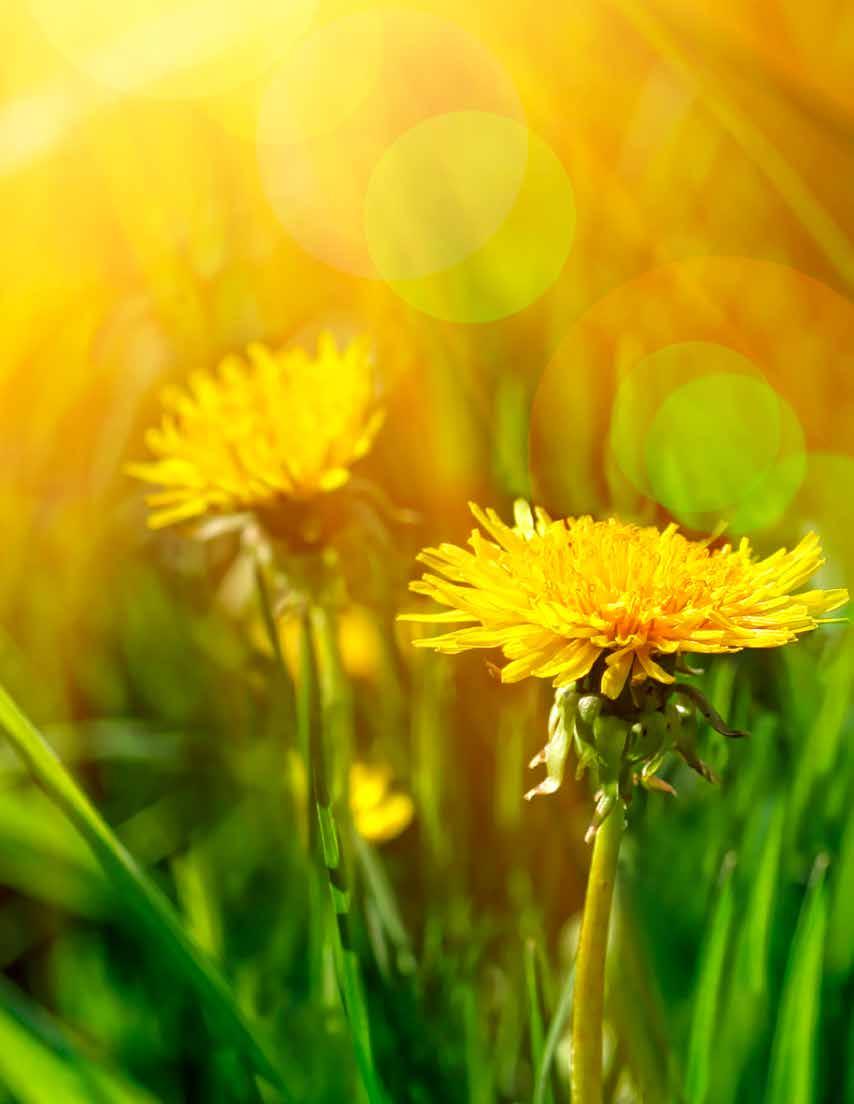
The leaves of dandelion are pinnately lobed and deeply serrated forming a “lion’s tooth” in outline. This is supposedly the origin of the “dent-de-lion.”
Carolus Linnaeus, the father of the Sandra Cunningham | Dreamstime.com
Simple and fresh and fair from winter’s close emerging,
binomial system of nomenclature, gave the dandelion the name Leontodon taraxacum. Dandelion’s scientific name has changed several times. It has been called Taraxacum leontodon, T. taraxacum, and T. vulgare, the last name because it is “common” (Porter, 1967).
Dandelion use has a rich history. It was among the original bitter herbs of the Passover. The Israelites were commanded to eat the Paschal lamb “with unleavened bread and with bitter herbs” (Exodus 12:8). Bitter herbs consisted of chicory, bitter cress, dandelion, hawk weed, sow thistles, and wild lettuce. Today these plants still grow on the peninsula of Sinai, in Palestine, and in Egypt (Hourdajian, 2006).
The genus name Taraxacum may come from the Greek word “tatassein” meaning “to disturb” or from the Persian word “tarkhashqún” meaning “bitter potherb” or “bitter endive” (Engels and Brickman, 2016). The species name officinale, of course, refers to the dandelion root’s use in medicine.
It has been used through history to treat disorders of the kidney and stomach. People believed that dandelions acted as a bladder and kidney stimulant, i.e., a diuretic. The French gave it the name “pissenlit” and the English called it “pissabed.” It is also believed to stimulate the liver and to increase blood circulation (Engels and Brinckmann, 2016).
A front-page article in the April 2021 issue of SNJ Today newspaper declared the “Dandelion Capital of the World” to be Vineland, New Jersey. Well-tended dandelions go from Vineland to markets in Baltimore, New York City, and Philadelphia. At the
yearly festival celebrating dandelions, attendees can sample a variety of dandelion dishes.
Because of their aggressive colonization in disturbed soils, farmers have questioned whether they should manage dandelions in their pastures. The plants don’t seem to affect the quality of pasture forage. In fact, livestock can eat dandelions (Bergen, Mayer, and Kozub, 1990).

Dandelion juice is a milk-like latex. This is true of dandelion’s nearest relatives as well... lettuce, chicory, hawksbeard, and hawk weed.
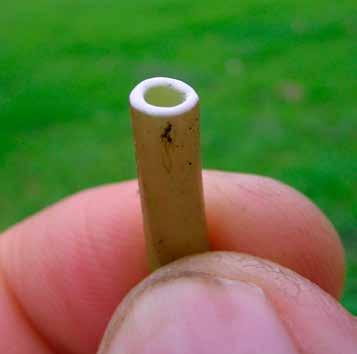
The leaves are delicious when young and are high in vitamins A and C, as well as the minerals iron, copper, and phosphorus. Their use is unlimited in a salad, steamed, or in a stir fry, or as an addition to soup (Cleveland Clinic Health Essentials, n.d.). They are good with onions, eggs, and bacon. They can be incorporated into fritters. If you think spinach, instead think dandelion greens.
You may have noticed dandelions in full sun, but they can grow in shade. They don’t seem to mind drought; their highly developed tap root stores food and water used by the plant to overwinter and in drought. The roots usually grow from about six to eighteen inches deep but can grow to ten feet giving dandelion the name “earth nail” by the Chinese (Duke Gardens, n.d.). (Imagine digging that one out!) The roots are contractile, so the growing point of the dandelion plant is kept near the surface of the soil. The roots contract while the leaves grow in the form of a circle or rosette of leaves close to the ground. The rosette makes it difficult for the seeds of other plants to compete. Look under the snow, and you may see dandelion rosettes. In areas where soil is compacted, dandelion roots do some good as they “dig” into the soil, aerating it. If they are dug out, other plant species have an easier time getting established.
The flower buds of dandelions grow from the top of the root. There are no true stems. If you cut off the plant top, the plant will simply regenerate. (This explains why mowing the lawn does not rid you of dandelions!) Chopping up the soil is no help either, as pieces of the taproot grow into new plants. The roots are edible though, and can be boiled, fried, or dried. Dried roots can be used as a coffee substitute similar to chicory, a close relative (Cleveland Clinic Health Essentials, n.d.). A gardening tip: Be careful when purchasing dandelion seed to grow in your garden for the leaves. “Italian dandelion” seeds, for example, are actually chicory. Pay attention to the genus and species name. The leaves simply don’t taste the same as true dandelion. Keep in mind that some cities and states prohibit growing dandelions (Mahr, n.d.).
The flower stalks are hollow pseudostems (false stems) ranging from about six inches to two feet. The flower heads are compound inflorescences growing to one to two inches in diameter. The pseudostem branches over and over. Each flower head is not a single flower with many petals but one hundred to three hundred identical ray flowers. Take a flower apart and count them. “He loves me. He loves me not.” Each ray flower has a yellow petal with five notches at the top which you can see with a magnifying glass.
The flowering peaks in early summer but can recur in September and October. Take the time to observe the behavior of dandelion flower heads. You will see that the heads open up through much of the day in the early spring, but close up, sometimes quite tightly, by the middle of the day from about June through August. The flower heads also remain closed on overcast days. Do you remember picking bouquets of
dandelions as a child (or perhaps later)? The flower heads close shortly after picking. I remember thinking that my bouquets needed water, so I put them in a glass of water. Nothing changed! The flower heads also close when the seeds are maturing. Then they reopen for their release. Voila!
I keep honeybees. All pollinators are welcome including the native mason bees, the native digger bees. I love watching bees, some fly species, and occasional wasps probing dandelion flower heads. Dandelions are unique. We have been taught that nectar attracts insects to plants. In the process of gathering nectar, insects pollinate the flowers, a good exchange. BUT dandelions don’t need insects to pollinate them, as the fruit (the holders of the seeds) develop asexually, the process termed parthenogenesis. Each individual flower produces seed whether or not an insect visits. This is called apomixis. It occurs in hundreds of plant species. Examples include citrus plants, wild beets, strawberries, and some forage grasses. This means that the seeds that are produced from these plants are all identical (Schader, 2021).
The seed heads of dandelions have interesting names. Two are “blowball,” an obvious reference to a childhood activity, and “monkshead,” what the flower head looks like after the seeds blow off (a tonsure). The fruits of dandelions are achenes—simple, dry fruits with one seed inside each fruit, about an eighth of an inch long. I looked at them under my binocular microscope. The seeds looked ribbed. The achenes don’t split open. They float away in the parachute structure. They germinate on top or near the top of the soil. They don’t need a dormancy period, so they germinate soon after landing.
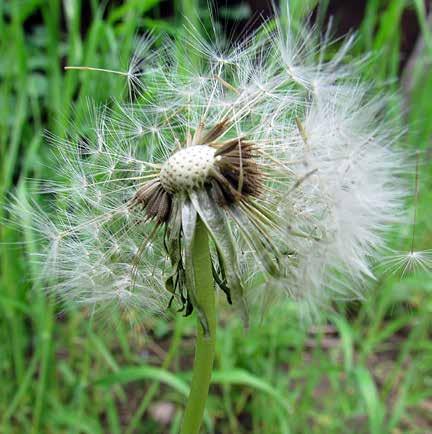
You can dig dandelions in the wild, cut fresh leaves, or cut the flowers for making wine. (I can tell you from experience that picking one gallon of dandelion flower heads is quite an undertaking.) Wash the flower heads. You then must remove the many thousands of individual flowers. Before harvesting the flower heads, please take care to ensure that they haven’t been sprayed with pesticides or sprayed upon by a passing creature. Or let the flowers be... for insects and for children.
If you wish to grow your own dandelions especially for greens, you can collect wild dandelion seeds. You may also purchase dandelion seeds from vendors such as Johnny’s Selected Seeds or Richter’s Herbs. Most people who intentionally grow dandelions do so for the leaves. For good tasting dandelion leaves, cast the seeds in rich well-draining soil. If you want neat rows in your garden, space the seeds about nine inches apart. Otherwise, plant
spacing is not critical. Cut the leaves when young to reduce the possibility of a bitter taste. If you aren’t interested in the flowers, cut them off so the plant’s energy goes back into leaf production. Fresh leaves can be harvested all season long.
The first time you choose to use dandelions in food, do so cautiously. Some people react to the milky sap. The greens may disagree with your digestive system (Carter, 2020). Don’t forget... there will be more dandelions for you to harvest later.
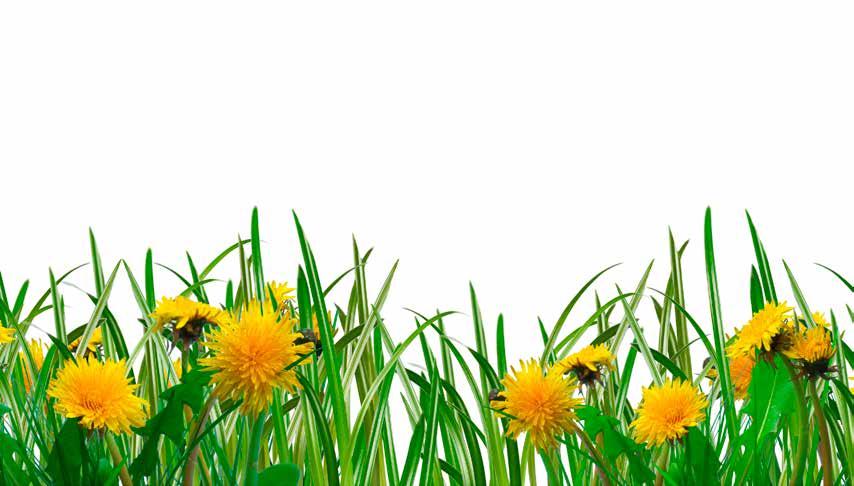
The lore of dandelions is, of course, fun. We have all held a dandelion flower head filled with seeds and blown them away. What remains are said to tell the number of remaining years of your life, or whether or not you will meet someone to love. If you catch one of the seed heads, you are lucky and may make a wish (Plant-lore, 2021). I did not know the lore of dandelions as a child. I blew the dandelion parachutes away because it was simply fun!
Literature Cited
Baumgardt, John Philip. 1982. How to identify flowering plant families. Portland, OR: Timber Press. Bergen, P., James R. Mayer, and Gerald C. Kozub. 1990. Dandelion (Taraxacum officinale) use by cattle grazing on irrigated pasture. Weed Technology. 4(2): 258-263. Accessed March 13, 2022. Available from jstor.org/stable/3987070
Carter, Gary. 2020. Rethinking the dandelion. Horticulture. 117(4): 15-17.
Cleveland Clinic Health Essentials. n.d. Can you eat dandelions? Accessed January 29, 2022. Available from health.clevelandclinic.org/dandelion-health-benefits/ Duke Gardens. n.d. Meet a Plant: Dandelion. Accessed January 31, 2022. Available from https://gardens.duke.edu/sites/default/files/Duke%20Gardens%20-%20Meet%20 a%20Plant%20Dandelion.pdf
Engels, Gayle and Josef Binckmann. 2016. Dandelion. Herbalgram. 109:8-15. Accessed January 29, 2022. Available from https://www.herbalgram.org/resources/herbalgram / Issues/109/table-of-contents/hg109-herbpro-dandelion/ Hourdajian, Dara. 2006. Taraxacum officinale. Introduced Species Project, Columbia University. Accessed January 29, 2022. Available from columbia.edu/itc/cerc/danoff-burg/ invasion_bio/inv_spp_summ/Taraxacum_officinale.htm
Mahr, Susan. n.d. Dandelion, Taraxacum officinale. Extension Service, University of Wisconsin-Madison. Accessed January 29, 2022. Available from https://hort.extension.wisc. edu/articles/dandelion-taraxacum-officinale/ Michigan State University. 2015. Dandelion. Accessed January 29, 2022. Available from canr.msu.edu/resources/dandelion-taraxacum-officinale
Plant-Lore. 2021. Dandelion. Accessed January 31, 2022. Available from https://www.plant-lore.com/dandelion/ Porter, C. L. 1967. Taxonomy of flowering plants, 2nd edition. New York: W.H. Freeman and Company.
Schader, Meg. 2021. How does a dandelion reproduce? Accessed January 29, 2022. Available from sciencing.com/how-does-a-dandelion-reproduce-12003581.html
he Herb Society of America urges members to grow native plants. Take a step back and look at your garden. It is likely that you, in fact, have plants that are native in various areas around the world! Our “native” plants may be recent arrivals in geological time. We grow them because we desire them for their use and delight.
WHERE IN THE WORLD DID PLANTS FIRST DEVELOP?
All living things originally evolved from a single common ancestor. Only those species best suited to the environment of that time, and of every time since, have survived until today.

The oldest known fossil of a vascular plant dates from 433-427 million years ago (Mya), when the location of the land masses of our planet were quite different from their locations today. Continents have drifted apart and coalesced multiple times. (Dahl and Arens, 2020).
The Gymnosperms (seed plants) (370 Mya) and Angiosperms
(conifers) (325 Mya) began to evolve during the Late Devonian (Dahl and Arens, 2020). None of those plants exist today. As newer plants evolve, they displace others. Seed plants displaced many, but not all conifers.
Flowering plants made their first appearance 130 Mya. Bees and other flying insects evolved at about the same time. Flowers needed bees to spread pollen and help them reproduce and bees needed flowers to provide food (Lloyd, 2008).
The last great extinction event, which killed the dinosaurs, also killed about 50% of all plant species. It occurred 66-65 Mya, with massive disruption of plant communities. This had a huge effect on plant distribution worldwide.
During the time between 5.33 Mya to 2.59 Mya, the continents continued to drift and move toward their present locations. The land bridge between North America and Asia formed. Much later South America became connected to North America (Tallis, 1991). Africa drifted toward Europe creating the Mediterranean
